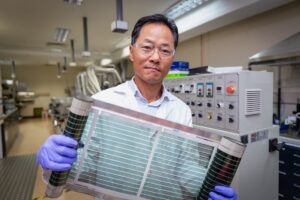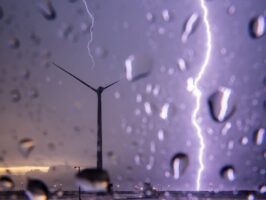Engineers from Stanford University have developed a pyramid-shaped lens device that they say can efficiently gather light from all angles, an innovation which could help solar arrays capture more light, even on cloudy days, and without using trackers to follow the sun.
Nearly all new solar farms use tracking devices to follow the sun’s movement across the sky and maximise output. But they do add costs to the project.
Stanford University engineering researcher Nina Vaidya believes that she has solved the need for solar trackers by designing a device that can efficiently gather and concentrate the light that falls on it, regardless of the light’s angle and frequency.
“It’s a completely passive system – it doesn’t need energy to track the source or have any moving parts,” said Nina Vaidya, who is now an assistant professor at the University of Southampton, UK.
“Without optical focus that moves positions or need for tracking systems, concentrating light becomes much simpler.”
Axially Graded Index Lens, or AGILE, basically looks like an upside-down pyramid with the point lopped off, and allows light to enter the square, tile-able top from any angle and regardless of strength, before being funnelled down to create a brighter output at the base.
This approach to solar generation will look very familiar to anyone who ever took a magnifying glass out to see if they could light a dry leaf – or an unfortunate ant.
But unlike the magnifying glass experiments of our youths, where the focal point of the sunlight through the glass moves as the sun does, Vaidya and her doctoral advisor Olav Solgaard were able to find a way to create a lens that takes rays from all angles, but always concentrates light at the same output position.
“We wanted to create something that takes in light and concentrates it at the same position, even as the source changes direction,” said Vaidya.
“We don’t want to have to keep moving our detector or solar cell or moving the system to face the source.”
The results of research into AGILE showed that they were able to capture over 90% of the light that hit the surface which then created output three times brighter than the incoming light.
Vaidya and Solgaard not only had to solve a way for the sunlight to always output at the same position, but for the creation of their prototypes had to find and create the right materials to maximise the efficiency of their theory.
They landed on using commercially available polymers and glasses, but AGILE has also been fabricated using 3D printing.
Installing a layer of AGILE on top of solar cells would subsequently make solar arrays more efficient and mean that the arrays would be able to capture not only direct sunlight, but also diffuse light that has been scattered by the planet’s atmosphere, weather, and seasons.
Moreover, instead of adding yet another layer, and therefore another manufacturing process, a top layer of AGILE could replace the existing solar array encapsulation which protects the panels, while also removing the need for solar trackers, and create space for cooling and circuitry to run between the narrowing pyramids of the individual devices.
More importantly, however, a top layer of AGILE would also reduce the amount of solar cell area needed to produce energy, subsequently reducing costs.
AGILE could also be used to encapsulate solar arrays being sent into space, helping to concentrate light without solar tracking while also providing the necessary protection from radiation.
“It’s one of these ‘moonshot’ engineering adventures, going right from theory to real prototypes,” said Vaidya.
“There are a lot of theory papers and great ideas out there, but it’s hard to turn them into reality with real designs and real materials pushing the boundaries of what was deemed impossible before.”
“Using our efforts and knowledge to make meaningful engineering systems has been my driving force, even when some trials were not working out.
“To be able to use these new materials, these new fabrication techniques, and this new AGILE concept to create better solar concentrators has been very rewarding. Abundant and affordable clean energy is a vital part of addressing the urgent climate and sustainability challenges, and we need to catalyze engineering solutions to make that a reality.”











